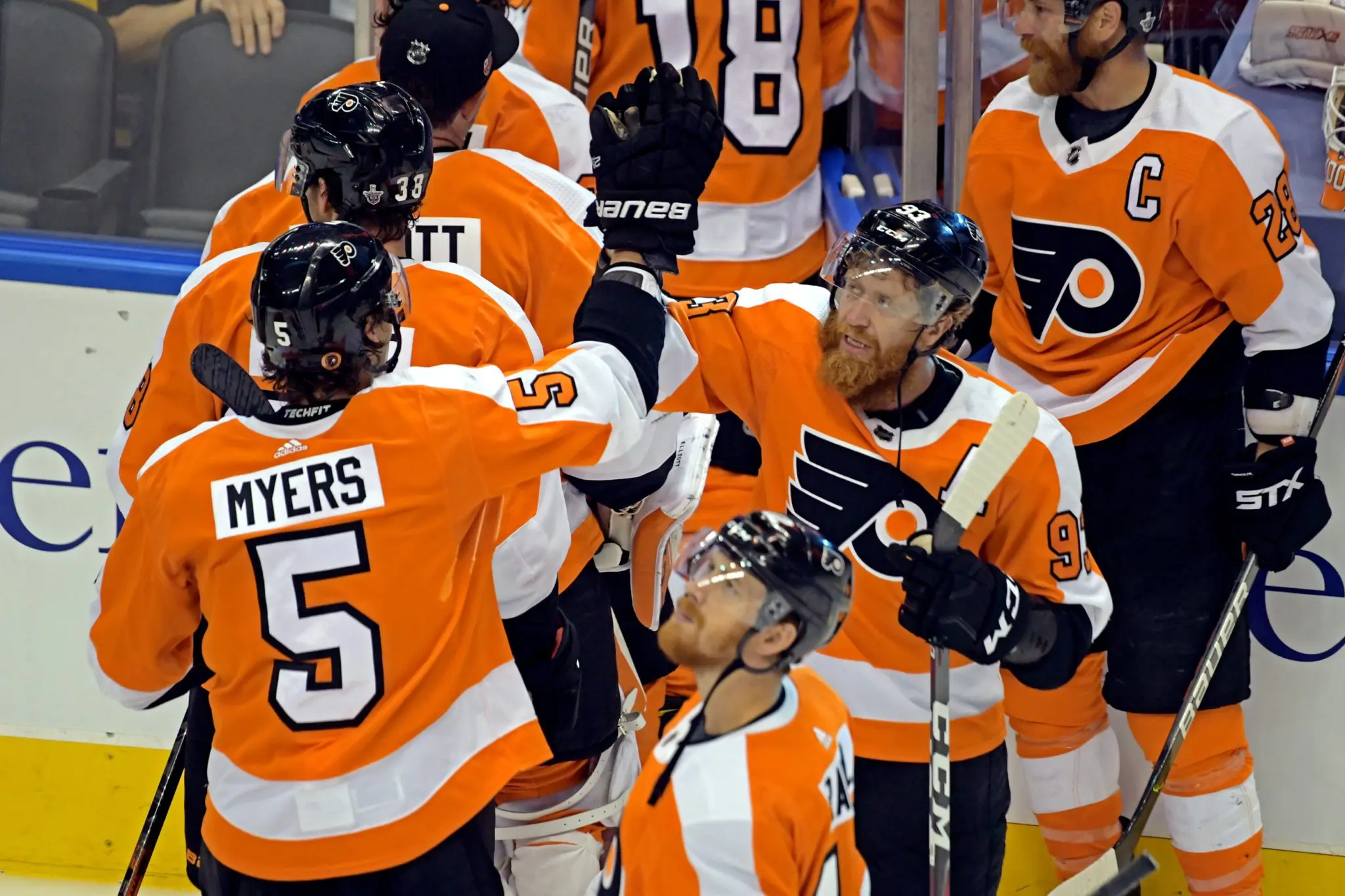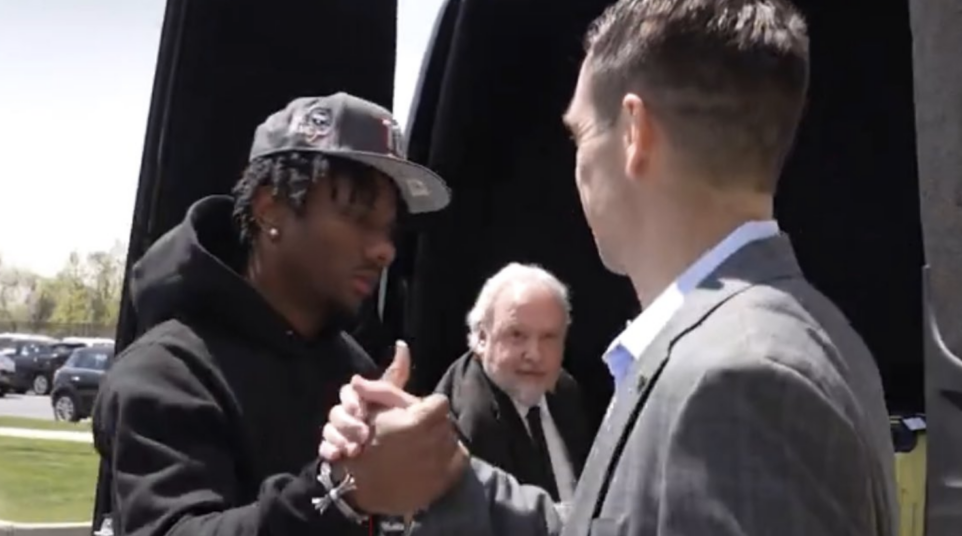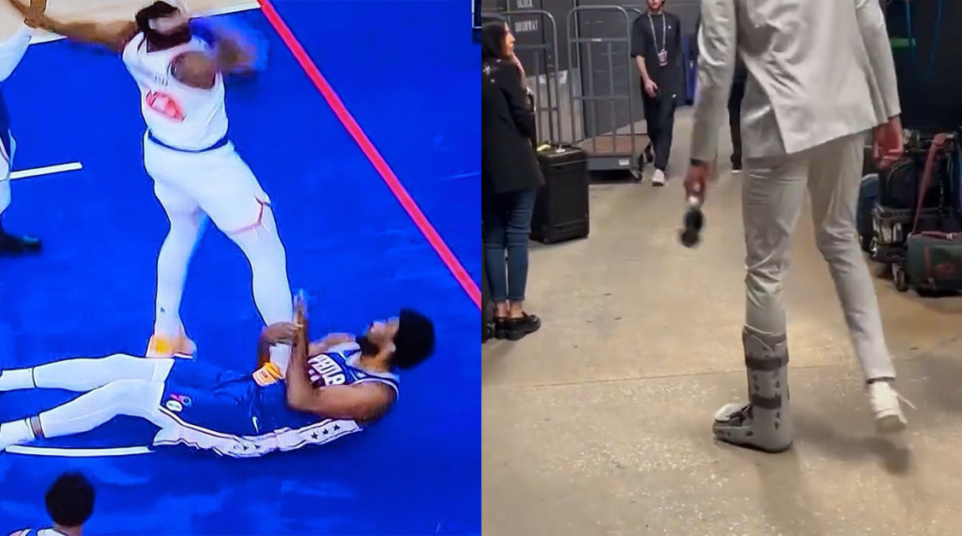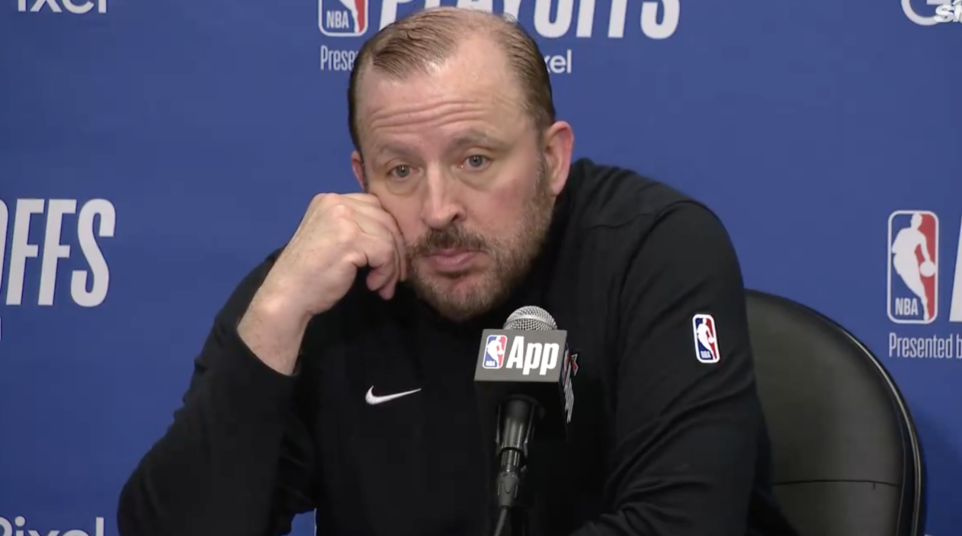
Bounce Back! What we Learned from Flyers 4, Islanders 3 (OT)
Things were going sideways. There’s no doubt about that. The Flyers saw their three-goal first period lead evaporate, with the New York Islanders tying the game on a controversial goal that revolved around the play being offside – and no, we’re not talking about 1980 and Leon Stickle.
It resulted in the Flyers’ first playoff overtime contest in eight years and it ended quite similarly to a playoff game against another New York-based team 25 years ago.
But in the end, the Flyers were able to survive against the Isles, 4-3, thanks to a thrilling game-winner by rookie defenseman Phil Myers, evening the Eastern Conference Semifinal series at one game apiece.
Before we even have time to breathe, Game 3 will be upon us (Thursday at 7PM) but before it gets here, let’s take a minute to reflect on what we learned in Game 2 on Wednesday:
1. Rookie bounce
I feel like we’re going to be working backwards in this recap, but, the things you’ll want to talk about happened later in the game.
So, before we get to the offside play that led to the Islanders’ tying goal and before we look at the Flyers’ fast start and before we talk about lineup changes for Game 2 or potential changes for Game 3, or anything else, we need to see how Myers joined Andy Delmore (2000) as the only Flyers rookie defenseman to score an overtime game-winner in the playoffs:
PHIL MYERS FROM DOWNTOWN. #AnytimeAnywhere | #NYIvsPHI pic.twitter.com/ym1Oxh7N88
— Philadelphia Flyers (@NHLFlyers) August 26, 2020
Myers was also the Flyers first defenseman to score an OT goal in the playoffs since Delmore and only the third rookie, regardless of position. It was also the Flyers’ first OT win in the playoffs since Danny Briere beat the New Jersey Devils in Game One of the 2012 Eastern Conference Semifinals.
These moments are iconic. I can’t believe the Flyers had gone 31 consecutive playoff games without going to overtime prior to this. Everyone remembers playoff overtime in hockey. To have been neglected of it for more than eight years seems almost criminal.
But, enough with the hockey rhetoric. Let’s break it down.
First of all, Myers deserves a lot of credit. He saw he had a lane to shoot and was calling for the puck to get a shot to the goal. He knows anything can happen with pucks that get through to the goalie… or even along the way.
And as you see that’s just what happens, his shot ticks off the shaft of Anders Lee’s stick, goes back down to the ice, bounces, and then skips up over Thomas Greiss’ pad and glove.
The work of the top line though leading up to the goal should also be pointed out. That shift was sensational, and really the top unit was good all game. Sean Couturier, who was much-maligned after the Game 1 loss for not producing, for looking less than his normal self, and for being one of the two vets named by coach Alain Vigneault as players who struggled against the Islanders (the other being Jake Voracek), had a chance to win it just before Myers but missed the net on his rebound chance, as it looked like his shot hit an Islander and popped up into the air.
Coots though, had the presence of mind to follow the shot, gather the puck, and rather than let the frustration of his near miss compel him to try and get it on net right away again, threw it back to the point to Myers for the goal.
Overtime goals in the playoffs sometimes have varying effects. They can sometimes propel a team forward – like the Keith Primeau five-OT classic – to win a series. Or, they can just be a sign that a team is hanging on against a better opponent for just a little while longer – like Claude Giroux against Chicago in the Stanley Cup Finals.
It will be interesting to see where this one takes the Flyers.
Oh, but before we move on, one more bit of nostalgia. This goal by Myers was eerily reminiscent of the Flyers first overtime game of the playoffs 25 years ago when Karl Dykhuis’ shot form the point deflected off a stick, bounced, and then went past Dominik Hasek to defeat the Buffalo Sabres. That Flyers team reached the Eastern Conference Finals. Is history repeating itself? Check out the goal for yourself:
2. Another Offside Controversy vs. the Islanders in the playoffs
Call it the ghost of Leon Stickle? Maybe?
Anyway, the Islanders were able to force overtime and erase a 3-0 Flyers lead when J.G. Pageau scored with 2:09 remaining.
It was a little bit fluky itself in that Travis Sanheim’s clearing attempt took a weird hop off the boards, hit a skate and kicked back into the zone right to Pageau who was alone in front and beat Carter Hart with a wrister.
But then, the Flyers challenged the play to suggest the whole series shouldn’t have counted as the Islanders were offside.
And at first glance, that appears to be the case:
I mean… looks pretty obvious to me. https://t.co/D2eJn0xWQz
— Anthony SanFilippo (@AntSanPhilly) August 26, 2020
However, this was a touch-up offside play. So, the Islanders can’t touch the puck in the zone until the man clears. As explained here by former Flyers (and Islanders) goalie Marty Biron:
The Islanders are offsides on the first picture but Bailey waits to touch the puck. So it’s a delayed offside. But by the time Bailey touches the puck (picture 2) everybody has cleared the zone and the delayed offside is cleared and the play is onside. pic.twitter.com/J3Sfv9uU2L
— Martin Biron (@martybiron43) August 26, 2020
Clouding the matter further is the question of whether Bailey carried the puck into the zone initially, meaning he had possession to begin with, or if possession wasn’t established prior to the zone entry:
Not when he brings the puck into the zone. That is deemed possesion. If a Flyers player put the puck into the zone you would be correct.
— Jason Myrtetus (@jasonmyrt) August 26, 2020
Also, it’s not crystal clear, upon review, that Bailey waited for his teammate to clear before touching the puck, which made the super-quick review by the officials curious. I mean, it’s really close. It’s a play I’d have to look at a few times to really check, and maybe solicit the opinions of the other linesman or the off-ice officials running the replay system.
But the refs were pretty adamant quickly that it was an onside play and the goal counted.
You could see both Alain Vigneault and JVR were a bit perplexed by this. They seemed to think the refs reviewed the wrong play.
This was critical as the Flyers were assessed a two-minute minor for a failed challenge, so not only did the goal count, but the Islanders got a power play in the final two minutes of regulation that could have won them the game.
Vigneault challenging that had to believe 100 percent that he was right. Flyers video coach Adam Patterson is a wizard with these challenges and communicated to the bench right away that this was offside.
Vigneault even stuck around after the third period to talk to the officials to find out what the heck happened.
However, the final verdict came from the coach himself who took full responsibility when he had this exchange in the post game press conference:
Can you clarify your decision on what looked like an offside? There were two instances there that looked like it could have been called offside. Which one were you specifically calling offside on?
“The one where we thought their player brought the puck back in and their player was still in the zone,” Vignault said. “Totally my responsibility. Bad call on my part. The linesman was right. The guy brought the puck back in but did not touch it until their player was out of the zone. Wrong call on my part. My mistake.”
Wow.
Could you imagine what would have happened if the Islanders would have scored on that power play? Twitter servers would have fried from overload in the Philadelphia region.
But it didn’t. The Flyers won. Most people will forget this even happened.
As for me, I’m still not sure Vigneault was wrong.
3. Missing a star
After the game, the three stars were announced. Kevin Hayes was the first star – and he was great. He scored the Flyers’ first two goals in the first period, when they built a 3-0 lead, and he was noticeable every shift he was on the ice in a positive way. Good call.
The second star was Myers – get a game-winner in OT in the playoffs, you get a star. OK fine.
The third star was Anthony Beauvillier of the Islanders. He scored the second New York goal on a 3-on-2 rush created by a missed chance by the Flyers on their own 3-on-2 rush seconds earlier. Beauvillier also had a strong overall game for the Islanders and the game did go to OT, so someone from the losing team needs to be a star, right?
Well, I don’t know about you, but Carter Hart was really good in this game. I mean, so much so that I thought he could have been the No. 1 star ahead of Hayes.
Hart made 31 saves to get the win. He was awesome in the games opening minutes when the Islanders were buzzing and the Flyers were a bit hemmed in.
He was great in the second period when the Islanders started pushing back and mounting their comeback.
And although he did allow the two goals in the third to tie the score, and maybe the second one is one you’d hope he wouldn’t let bleed through, time and again Hart was the difference maker in this contest.
All that said, he’s probably taking a seat in Game 3….
4. Lineup changes
First, Vigneault boldly scratched Scott Laughton after an awful Game 1 and a series of games against Montreal where he was not at his best. JVR was re-inserted into the lineup and had a strong game all-around. Robert Hagg also was back in the fold as Shayne Gostisbehere was sent back to the press box after another inconsistent game riddled with misplays and turnovers.
These moves seemed to work.
However, I wouldn’t expect Laughton to be out long. In fact, I wouldn’t be surprised if he was back in the lineup for Game 3. Joel Farabee didn’t have the greatest two games against the Islanders and if the goal was to send a message to Laughton and jump start him, he could replace Farabee as well.
Don’t be shocked to see that tonight.
Also, don’t be shocked to see Brian Elliott in goal instead of Hart.
That’s right. As good as Hart’s been, the Flyers really need to manage him in this series after the NHL put out a ridiculous schedule.
The two teams played Monday at 7, Wednesday at 3, play tonight at 7 and Saturday at Noon. That’s four games in 89 hours. What the hell are they thinking?
Hart is great. He’s the No. 1 guy and will continue to be in the playoffs, but he’s not superhuman. He needs a game off, and this is the one that makes the most sense.
Elliott is a very capable backup. He’ll give the Flyers a great game, I’m sure, in Game 3.
[the_ad id=”103880″]





